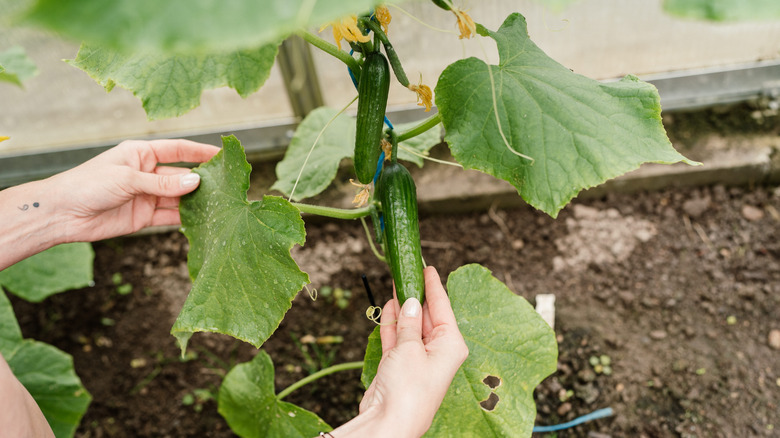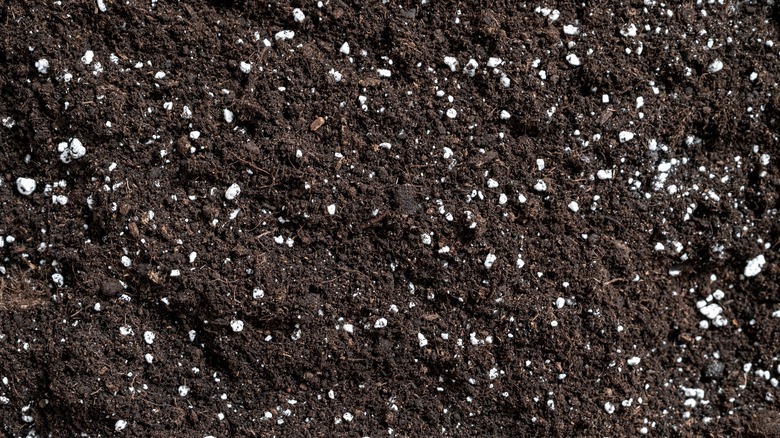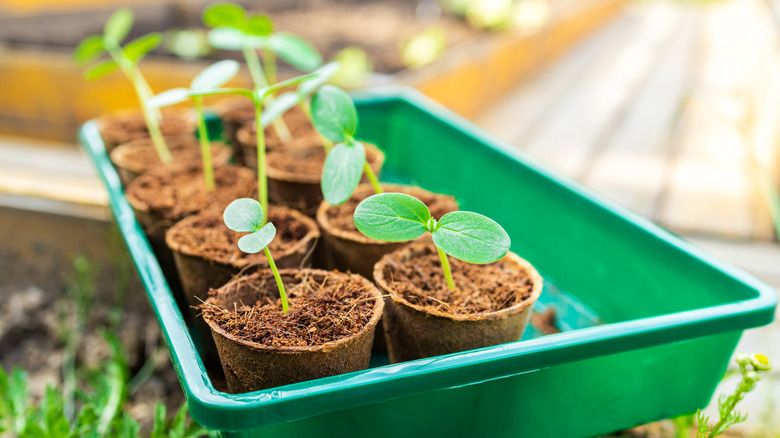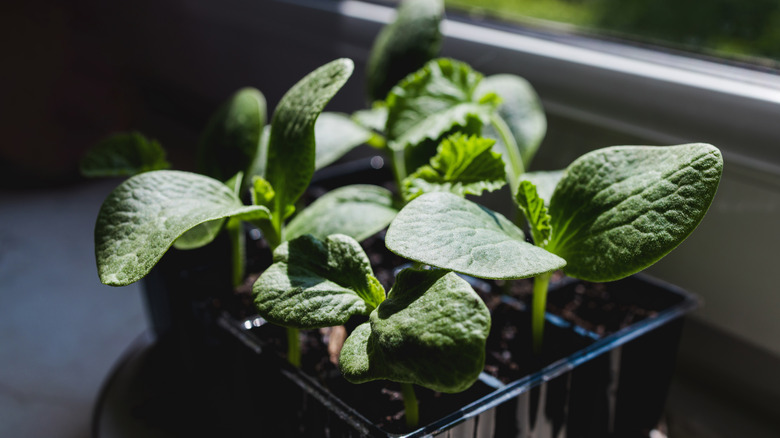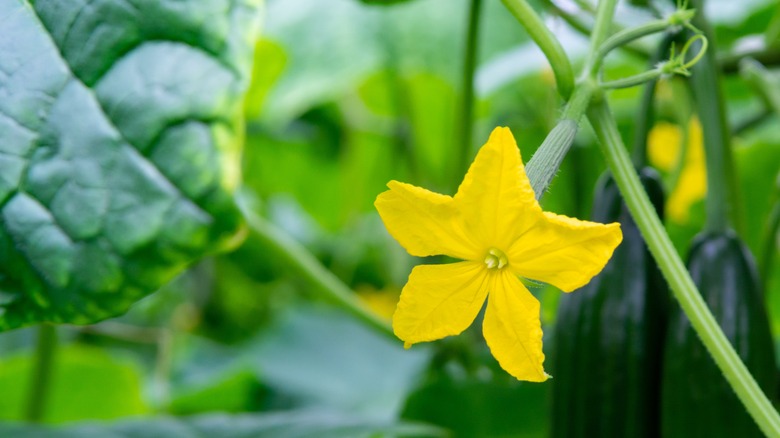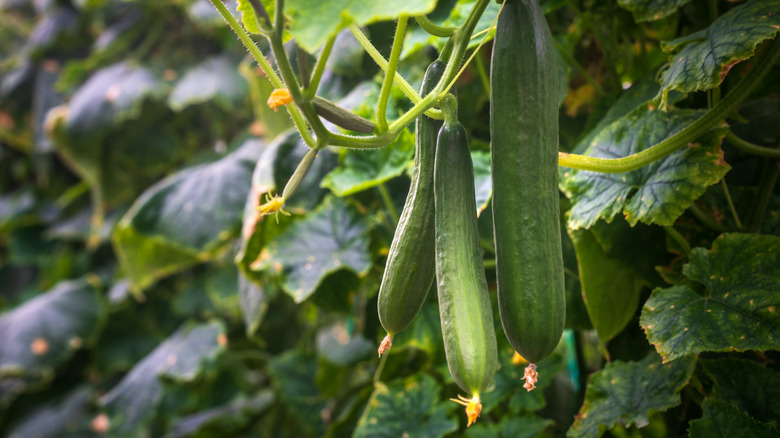The Stages Of Growing Cucumbers From Seed To Fruit (A Visual Guide)
We may receive a commission on purchases made from links.
Growing your own cucumbers from seed is a straightforward and delicious way to supplement your dinner table with freshness and imbue your meals with the taste of summer. Cucumbers are generally easy to grow and care for; however, they develop unique needs at various stages of growth. If you're hoping for a bountiful cucumber harvest come fall, you must understand these stages of growth along with all the special care requirements they entail.
After you plant the cucumber seeds, the first growth stage is germination. During this stage, the seeds leave dormancy and sprout. Next comes the seedling stage. This is a precarious phase in the young plants' lives, as the fragile young seedlings are particularly vulnerable to unsuitable climatic conditions. As true leaves emerge, the cucumber plants enter the vegetative stage; at this point, the quickly maturing plants become more established and resilient. Eventually, the cucumbers start blooming, and if pollination is successful, you won't wait long to see fruit appear on their vines. Below, we'll walk you through each of these stages in greater detail and explain how to care for your cukes throughout each phase.
The cucumber seeds germinate
Seed germination is the first stage of cucumber plant development. The cucumber seeds are dormant when you plant them, but their tiny shells contain all the life essentials they'll need to turn into seedlings. Inside, there's the plant embryo, complete with the root, stem, and leaves, and a stash of nutrients to last the germination phase. As the seeds come in contact with moisture and oxygen, and the surrounding soil and air temperature climbs inside your germination tray, the embryo cells inside them begin to grow. The germination process can take anywhere between three and 10 days for cucumber seeds, depending on the climatic conditions. At one point, this growth causes the seed to crack, and the plant's root, stems, and leaves will appear in quick succession. Once you see these signs of life poke through the soil, you'll know that the germination phase is complete and the seeds have completed their transformation into seedlings.
The more warmth and humidity you're able to provide, the shorter (and more successful) the germination cycle will be. Ideally, you'll want keep the soil temperature between 60 to 85 degrees Fahrenheit during this stage. If you've started your cukes indoors and are struggling to achieve or maintain this temperature, try using a heat mat like this one from BN-LINK to warm the trays from the bottom. Whereas some seeds need sunlight to germinate, this isn't the case with cucumbers — the seeds should be inserted into the soil to a depth of an inch.
The seedlings start to sprout and mature
The end of the germination stage coincides with the emergence of cucumber seedlings. At this stage, the young plants comprise nothing more than a tiny, delicate stem with one or two leaves. This stage lasts for about two to four weeks, during which the young plants undergo quick root growth. The roots begin to spread laterally as the plants seek out moisture and nutrients in the growing medium.
The cucumber seedlings are as fragile as they look at this stage and are particularly susceptible to harsh or inconsistent growing conditions. For one, they need plenty of light for steady development. When lighting is insufficient, the seedlings' stems will stretch upwards in search of more light, and you'll end up with tall, lanky plants. The same phenomenon occurs if the seedlings are growing too close together and have to compete for light. Getting the temperature right is equally important — the warmer the temperatures, the faster the seedlings will grow and mature, and vice versa. If you're able to control the temperature for your young plants, keep it in the 70 to 75 degree range during the day and between 60 and 65 degrees at night. After three or four weeks under these favorable conditions, and when the seedlings have two to three leaves, you should be able to start hardening the young plants for their eventual transplant to the garden. The hardening process prepares the plants for the harsher, uncontrolled outdoor environment.
True leaves begin to emerge
The tiny round leaves your cucumber seedlings emerge with are not considered true leaves. Their scientific name is cotyledons, and they're commonly called seed leaves. Any leaves that show up after on the cucumber plant are called true leaves.
Getting their first true leaves is an important milestone for cucumbers, one that ushers in what's known as the vegetative stage. Although cotyledons have the capacity to perform photosynthesis, they're only designed to do so temporarily until the true leaves can take over the function. As more leaves emerge, the photosynthetic process truly kicks into gear and starts producing more nutrients for the growing plant.
If you've planted the cucumbers indoors, this is the time to transplant them outside. Don't wait too long, either. According to the University of Saskatchewan, the best time to transplant cucumbers is while the young plants have two or fewer sets of true leaves. Ideally, the outdoor soil temperature should no longer dip below 65 degrees Fahrenheit, and any risk of frost should be gone when you begin to transplant the cukes into the garden. When you do, be sure to leave at least 24 inches of space between the transplants within a row and at least 4 feet between the rows. If you plan to trellis the cukes, insert the support structures into the soil before you transplant the young cucumbers outdoors. Find out how to avoid common mistakes when growing cucumbers on a trellis.
The plant starts to flower
As the cucumber plant continues to mature and grow, you'll notice its budding yellow flowers. Cucumbers are monoecious plants, meaning that they produce both male and female flowers. The first flowers to emerge are male. These flowers will not bear fruit — they're only there to invite pollinators. The female flowers appear not too long afterward. They look much like their male counterparts at a glance, but you can tell the two apart by looking at the flower's base. The female flowers emerge with the tiny fruit bulging at their base, whereas the male flowers don't.
In a natural environment, pollinating insects deliver pollen from the male to the female blooms. This process fertilizes the female flower and continues to develop into the cucumber fruit. But if you're growing cucumbers on the balcony of a highrise, your access to pollinating creatures may be limited. Don't despair, though — now that you know how to tell the male and female cucumber flowers apart, there's a way for you to step in and perform the pollination yourself. Hand pollination is often used in greenhouses, with impressive results. To hand-pollinate your cukes at home, gently touch the center of the male flower with a brush or a cotton swab to collect the pollen. Then, touch the center of the female flower with the tip of the same brush or cotton swab to fertilize it. Repeat the same process on all your cucumber plants.
Flowers give way to fruit
Successful pollination ushers in the final stage of growing cucumbers: female flowers give way to fruit. You've already seen the tiny fruit at the base of the female flowers. Well, now these babies will start to grow — and do so quickly. Usually, you should be able to harvest the cucumbers just one week after the flowers emerge! As the tiny cucumbers grow before your eyes, it's important that you continue irrigating the plant consistently, otherwise you risk stunting the growth of the fruit.
That said, a word to the wise: Don't waste your time waiting for the fruit to grow larger and larger. The longer you wait to harvest your garden's cucumbers, the larger the fruit will get and the less flavor it will have. Not only are these overgrown cukes less delicious, but their skin is harder to chew through, and their seeds are quite large. Also, note that leaving large cucumbers on the vine will cause the plant to decrease production. On the other hand, harvesting the cucumbers frequently will encourage the plant to continue flowering and producing more fruit.
